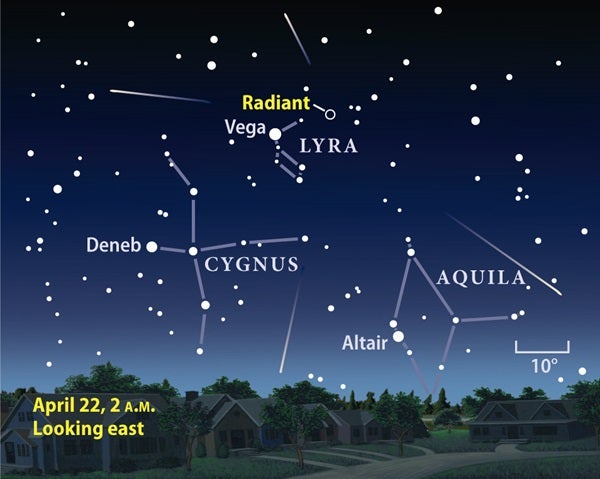Meteor showers offer everyone, not just avid amateur astronomers, a chance to witness a cosmic spectacle.
Named after the constellation from which the meteors appear to radiate, the annual Lyrid shower produces the bulk of April’s meteors. The shower remains active between April 16 and 25. Astronomers predict the shower will peak in the predawn hours of April 22.
Lyra is easy to find because it’s marked by the brilliant blue-white star Vega. Vega ranks fifth brightest of all nighttime stars.
It’s best to view meteor showers without optical aid. Viewers should use just their eyes, so as not to restrict the field of view. Before midnight, face eastward, and look about halfway up. After midnight, looking overhead will probably net you the most meteors.
Lyrid rates vary from year to year, with the peak averaging around 20 meteors per hour under ideal conditions. More often than not, the highest level of activity lasts only a few hours. The radiant lies in the constellation Lyra, near its border with Hercules. Although this area rises before midnight, the best time to view the Lyrids comes in the 2 or 3 hours before dawn. As always, you’ll see more meteors if you observe from a dark location.
Lyrid meteors are fast and average as bright as the Big Dipper’s stars. These particles we see as meteors originated from Comet Thatcher (C/1861 G1).
Meteor showers are great social and family events. Organize a group of skygazers, and head out of town to a dark location. Bring lawn chairs, sleeping bags, and hot drinks to stay warm. Plan to wear winter clothing — many observers are surprised at the chill of spring’s late-night air.
- Podcast: How to observe the 2009 Lyrid meteor shower — Astronomy magazine Senior Editor Michael E. Bakich helps you observe the 2009 Lyrid meteor shower, one of the year’s best.
- Interactive star chart — StarDome will give you an accurate map of your sky. This tool will help you locate the meteor shower’s radiant in the constellation Lyra.
- Video: How to observe meteor showers — Enjoying a meteor shower requires only comfort and patience. Senior Editor Michael E. Bakich gives tips on spending a night under “shooting stars.”
- Meteors and meteor showers — You can see a “shooting star” on any dark night, but some nights of the year are much better than others.
- Free weekly e-mail newsletter — Receive news, sky-event information, observing tips, and more.











